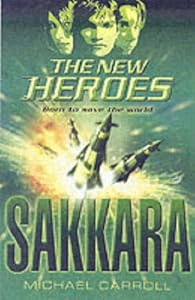 Cover of SAKKARA Cover of SAKKARA |
| Image via amazon.com |
Can super-heroes survive without the art of comic books or the spectacle of film to tell their stories?
Michael Carroll would argue they can.
Carroll is the author of the Quantum Prophecy series published in the U.S. by Philomel Books. (Originally published in the U.K., the series is known there as The New Heroes.)
Set in a world in which super-heroes once existed, but no longer do, the three-book series follows the adventures of two teens as they discover they have super-powers and set out to lead a new generation of heroes.
Quantum Prophecy has all the elements that make super-hero stories irresistible: powers, villains, secret headquarters, gadgets, betrayal, action, and teen romance.
The only thing missing is the art. But Carroll’s writing is so deft, it assists readers in supplying their own visuals.
The first book, The Awakening (Quantum Prophecy in the U.K.), begins with an event called Mystery Day, in which all of the super-heroes – including Quantum, Paragon, Titan, Energy, and Diamond – go up against a super-villain called Ragnarök. Though victorious, the heroes suffer great personal loss and mysteriously vanish.
Ten years later, two boys – Colin Wagner and Danny Cooper – discover they have powers. Colin is super-strong, can hear conversations from a great distance, and is pretty much invulnerable; Danny possesses super-speed and receives a disturbing vision of what could be his future. Their lives are turned upside down when they discover their parents are retired super-heroes: Colin’s mother and father were Energy and Titan, and Danny’s father was Quantum. More, someone else has discovered their identities, so the two boys and their families make a mad dash to avoid being captured.
The second book, The Gathering (Sakkara in the U.K.), which I'm currently reading, begins with Colin embarking on his super-hero career as the second Titan (or “Kid Titan,” as the media calls him to his annoyance). Still a young boy, Colin makes a mistake that costs him, his family, and his friends dearly: while preventing a mugging, he loses his mask, resulting in his identity becoming public knowledge.
Colin, Danny, and their families are whisked away to a secret super-hero community called Sakkara, near Topeka, KS, where they meet other teens with powers. However, their existence is threatened by an acid-scarred super-villain called Dioxin, who seeks to discredit the new heroes before they’ve even started.
The story's many twists unfold at breakneck speed. However, Carroll affords us plenty of time to get to know these young heroes and become immersed in their world. He never forgets that having super-powers would be fun. After Colin learns the hard way that he cannot fly, the others brainstorm new codenames for him. (Two suggestions: Pancake and Roadkill.)
But the story isn’t all laughs. Dioxin and his group of thugs murder innocent people (the violence is mostly not “shown” – Carroll tells us what we need to know but does not dwell on blood and gore). More, the story touches on contemporary themes such as gated communities and how ordinary people isolate themselves from others to feel safe.
And part of the fun is watching Carroll take super-hero tropes and turn them upside down. One character learns, for example, that his father is not who he appears to be. While the notion of one’s parent being replaced by a super-villain is as old as super-heroes themselves, the idea takes on new significance here.
Though intended for a Mid-Grade/Young Adult audience, Quantum Prophecy will appeal to anyone who loves super-heroes.
So, if you’re tired of the same old same old in super-hero comics these days, check out Carroll’s world. You won’t even miss the pictures.




No comments:
Post a Comment